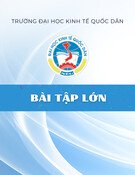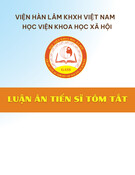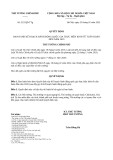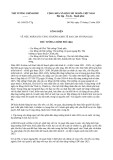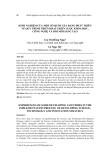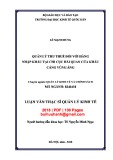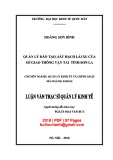Ministry of Agriculture & Rural Development
CARD Project Progress Report 004/04VIE: Better Breeds of Common carp (Cyprinus carpio L.) for Small-scale Fish Farmers
MS6: SECOND SIX-MONTHLY REPORT
January 12, 2006
1
1. Institute Information
Project Name
Better Breeds of Common carp (Cyprinus carpio L.) for Small-scale Fish Farmers
Research Institute for Aquaculture No. 1 Vietnamese Institution
Dr Tuan Anh Pham Vietnamese Project Team Leader
Deakin University Australian Organisation
Dr Chris Austin Australian Personnel
8 March, 2005 Date commenced
30 January 2007 Completion date (original)
28 February 2007 Completion date (revised)
Second Six Monthly Reporting period
Contact Officer(s)
In Australia: Team Leader
Dr Chris Austin Professor/HOS 08 8946 7276 08 8946 6151 chris.austin@cdu.edu.au Telephone: Fax: Email:
Name: Position: Organisation Charles Darwin University In Australia: Administrative contact
Dr Jenny Carter Manager Research 08 8946 6708 08 8946 7199 jenny.carter@cdu.edu.au Telephone: Fax: Email: Name: Position: Organisation Charles Darwin University
2. Project Abstract
Increased inland fish production is a high priority for the Government of Vietnam particularly in the context of rural development in relation to food security, poverty alleviation and income generation. This project aims to assist the continued development of genetically improved common carp breeds, the effective dissemination of these breeds from central research institutes to provincial hatcheries for distributions to small scale farmers and further development of research capacity in genetics in relation to selective breeding and brood-stock management. Excellent progress has been made with in the first six months of this project. Almost all inputs have been achieved and all milestones have been met or exceeded. A questionnaire to investigate and document fish breeding practices and assess knowledge levels has been developed, tested, refined and ~100 stakeholders interviewed. Over fifty populations of carp have been sampled from research stations, provincial hatcheries, private hatcheries farmers and wild populations. Two workshops were conducted
1
in May, one for hatchery personnel and farmers and one for young scientists. Laboratory equipment has been purchased and is being used for research and training.
3. Executive Summary
Excellent progress has been made with this project. The project commenced 8th March, 2005 and almost all inputs have been achieved and all milestones have been met or exceeded that were planned for the second six months. The questionnaire designed to reveal and document fish breeding practices and assess knowledge levels among farmers and hatchery personnel has been used as the basis for the interviewing of 133 stakeholders from 21 provinces. Preliminary summaries and analyses of the data have been undertaken. Sampling of carp populations has been completed with tissues sample taken from over 2000 individuals representing sixty populations of common carp from research stations, provincial hatcheries, private hatcheries, markets and from fish farmers through out Vietnam and DNA genotyping has been completed for 20 populations and is ongoing. These preliminary results reveal interesting insights into the effects of inbreeding and dissemination of genetically improved strains and have been submitted for publication in the journal Aquaculture. Technical training for 2 young Vietnamese scientists in Australia has been carried out in November and December, 2005.
4. Introduction & Background
The general aim of this project is to identify better breeds of common carp and increase the utilisation of such fish by small-scale farmers as means of increasing yields and lowering costs, and thereby contributing significantly to poverty alleviation and income generation for communities heavily dependent on fish aquaculture for livelihoods and food security.
Common carp was chosen as the target species as it is the most important cultured fish species in Vietnam (approximately 20,000 metric tons produced per year) with a very large number of people, including those in low income regions (e.g. highlands) and ethnic minorities, dependent upon it for food security and income. Further, the Vietnamese Government has in the past, and continues to invest significant resources into the production and dissemination of genetically improved breeds of this species, and there is significant local expertise in the area of genetics and breeding (e.g. staff of the Research Institute for Aquaculture No. 1).
The specific objectives of this project are to: (1) document current fish breeding and brood- stock management practices in relation to the selection and maintenance of genetically improved common carp breeds at the institutional, hatchery (provincial and private) and small-scale farm levels; to assess knowledge levels relating to fish breeds and selection of seed stock by small scale farmers; (2) determine genotypic and phenotypic diversity among common carp genetic resources (breeds), both wild and domesticated, available for aquaculture within Vietnam and examine the success of dissemination of genetically improved breeds to small scale farmers; (3) increase success and efficiency of common carp breeding, broodstock management and seed stock production by small scale farmers and hatchery personnel; (4) increase capacity of young researchers and technicians to contribute to research and development in the fields of genetics of broodstock management, molecular genetics and fish genetic improvement; and (5) To demonstrate to farmers, on farm, the advantages of using genetically improved breeds of carp.
2
the use of modern (molecular genetic) and
The approach adopted for this project involves a novel combination of traditional and modern methods. Thus the understanding of common carp genetic resources in Vietnam and the success of the dissemination of genetically improved breeds to small-scale farmers will be based on traditional phenotypic (morphological, pond growth trials) approaches, and through demonstration (by stocking improved fish breeds into farmers ponds) and by interviewing stakeholders. Also a more ‘de- centralised’ approach to both understanding carp genetic resources will be taken using comprehensive geographic sampling of domesticated and wild populations and through capacity building for provincial hatcheries (via training programs) to enable better brood- stock management and improve fish breeding.
5. Progress to Date
5.1
Implementation Highlights
The principal achievements for the reporting period have been:
(1) the successful training of two young scientists from the Research Institute for Aquaculture No. 1, at Deakin University in advanced genetic technologies and statistical procedures
(2) the interviewing of 133 farmers and hatchery personnel to determine knowledge levels relating to fish breeding and genetic improvement and common carp breeding practises by small scale fish farmers and hatchery personnel. Preliminary analysis and summary of data completed. (3) sampling and genotyping of common carp populations obtained from throughout Vietnam which has exceeded expectations
5.2 Smallholder Benefits
The most direct benefits to small-scale fish farmers to date have been through the workshops run at the Research Institute for Aquaculture No. 1 for fish farmers, hatchery personnel and the interviewing of small scale farmers in relation to the documentation of current fish breeding and brood stock management practices.
5.3 Capacity Building
A contribution to capacity building at the institutional level has been made through the advanced training programs delivered to two young scientists at Deakin University.
5.4 Publicity
None to date.
5.5 Project Management
Management of the project as been effective.
3
6. Report on Cross-Cutting Issues
6.1 Environment
No issues.
6.2 Gender and Social Issues
The two young scientists trained at Deakin represented each gender.
7. Implementation & Sustainability Issues
7.1
Issues and Constraints
The implementation of the project has been complicated by the movement of staff and unanticipated demands from other projects for the Australian partner. These problems have been overcome by accessing the services of other personnel or in some cases increasing the time commitments of nominated staff. The Australian Leader, Austin has now taken up his new position as Professor and Head of School of Science and Primary Industries at Charles Darwin University, Darwin, Australia. Letters of Agreement to transfer the project from Deakin to Charles Darwin University are in process.
7.2 Options
Charles Darwin University has advertised for a Research Fellow in Genetics and an appointment is expected to be made in the next month. This person will be able to support Dr Austin’s research program in aquaculture and fish and invertebrate genetics including this project.
7.3 Sustainability
No major issues other than those indicated above.
8. Next Critical Steps
The next steps are:
(1) Complete the genotyping of carp and analysis of DNA data (2) Preparation of notes for farmer workshop (3) Workshop for farmers (4) Technical training in Australia II (5) Identify farmers for on-farm trail of improved carp (6) Breeding of carp for on-farm demonstrations (7) Raising of fingerlings (8) Stocking of fingerlings into ponds and grown There are no major constraints envisaged to objectives as outlined.
4
The only other additional step is to complete the transfer the project from Deakin University to Charles Darwin University.
9. Conclusion
Progress of this project has been highly satisfactory and all objectives established for the second 6 month period have been met or exceeded.
5

